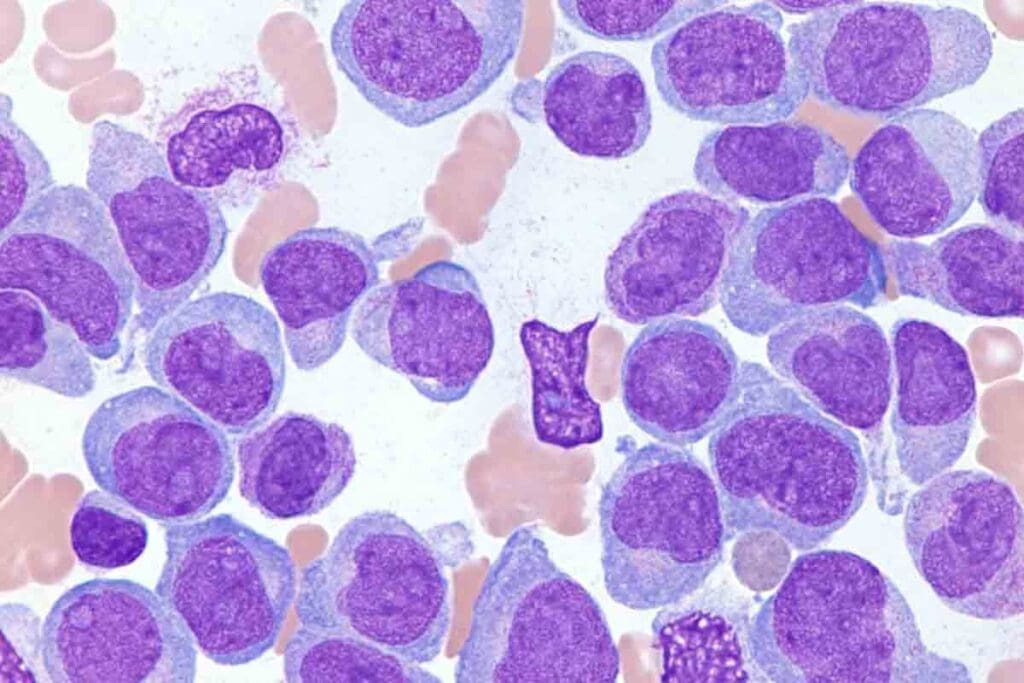Last Updated on November 20, 2025 by Ugurkan Demir

Bone marrow disorders are a wide range of diseases. They happen when the body doesn’t make enough, or makes bad, blood cells.
These issues can come from genes or happen later in life. They are often linked to a bone marrow abnormality, affecting the soft tissue inside bones where blood cells are created.
At Liv Hospital, we understand how complex these conditions are. We focus on myelodysplastic syndromes and offer top-notch tests and team care.
Knowing what causes these disorders is key. It helps doctors find the right treatment.

Deep inside our bones, there’s a special tissue called marrow. It’s key for making blood cells. Bone marrow is a vital organ that helps our health by creating the cells in our blood.
Bone marrow is found in bones like the hips and thighbones. It’s where blood cells are made. It’s filled with blood vessels, including sinusoids, which help move nutrients and waste.
This tissue has hematopoietic cells and stromal cells. These cells work together to keep the bone marrow running smoothly.
The bone marrow makes red blood cells, white blood cells, and platelets. This process, called hematopoiesis, starts with hematopoietic stem cells. These cells turn into different types of blood cells.
| Cell Type | Function |
| Red Blood Cells | Carry oxygen throughout the body |
| White Blood Cells | Play a key role in the immune system by fighting infections |
| Platelets | Essential for blood clotting and preventing excessive bleeding |
A healthy bone marrow is vital for a strong immune system. It makes white blood cells, which fight infections. The bone marrow’s ability to create diverse immune cells helps our bodies fight off diseases.
Also, the bone marrow stores immune cells. It releases them when needed. This is key for our body’s defense, showing how important healthy bone marrow is for immunity.

It’s important to know what a bone marrow abnormality is. These issues affect how blood cells are made. This can lead to health problems.
A bone marrow abnormality means the marrow can’t make enough healthy blood cells. This can happen for many reasons, like genetic problems or environmental factors. Doctors sort these issues into groups based on their causes and how they work.
Myelodysplastic syndromes are a type of disorder where blood cells don’t form right. This leads to more bad cells than good ones.
Hematopoiesis is how bone marrow makes blood cells. It’s a complex process that needs many cell types and growth factors. When this process goes wrong, it can cause bone marrow problems.
These problems can be caused by genetic issues, toxins, or diseases. For example, in myelodysplastic syndromes, blood cells don’t mature right. This means there are more bad cells than healthy ones.
When hematopoiesis is disrupted, it can cause many issues. These include anemia, infections, and bleeding problems. This depends on which blood cells are affected.
It’s key to spot early signs of bone marrow problems. Common signs are tiredness, often getting sick, and bleeding easily. These happen because the marrow can’t make enough healthy blood cells.
Getting a diagnosis early is vital for treating bone marrow disorders. If you’re feeling these symptoms, see a doctor right away.
Bone marrow disorders include myelodysplastic syndromes, Fanconi anemia, and sideroblastic anemias. These conditions affect the bone marrow’s ability to make healthy blood cells. This leads to different health problems.
Myelodysplastic syndromes (MDS) are disorders where blood cells don’t form right. The bone marrow can’t make healthy, mature blood cells.
Characteristics of MDS:
Aplastic anemia is when the bone marrow can’t make blood cells. It can be caused by toxins, some medicines, and viruses.
Causes and Characteristics:
| Cause | Characteristics |
| Exposure to toxins | Bone marrow failure, reduced blood cell production |
| Certain medications | Pancytopenia, fatigue, infections |
| Viral infections | Anemia, bleeding, infections |
Fanconi anemia is a rare genetic disorder. It affects the body’s ability to make new blood cells. It leads to bone marrow failure and a higher risk of cancer.
Genetic Factors: It’s caused by mutations in genes that help fix DNA. This shows how important genetics are in bone marrow disorders.
Sideroblastic anemias are when iron builds up in mitochondria, stopping hemoglobin production. It can be inherited or caused by other factors.
Studies on bone marrow diseases show trends in how common they are and who gets them. Knowing these stats helps doctors and researchers fight these diseases better.
Bone marrow disorders, like myelodysplastic syndromes (MDS), hit a lot of people in the U.S. MDS affects about 20,000 to 30,000 people each year. It gets more common as people get older, making it a big health issue for seniors.
Age plays a big role in who gets bone marrow diseases. Older adults, like those over 60, are hit hard by MDS and other diseases. Gender and ethnicity can also change who gets these diseases. For example, MDS seems to affect men more than women.
Demographic Distribution: Research shows that bone marrow disorders affect different ethnic and racial groups differently. Knowing this helps us target health efforts better.
The number of people getting bone marrow diseases has gone up over the years. This increase is due to more older people and better ways to find these diseases. Finding diseases early can lead to better care for patients.
Implications for Public Health: The rise in bone marrow diseases means we need to keep researching and working on health efforts. By understanding these diseases, we can find ways to prevent, detect early, and treat them better.
Bone marrow disorders come from many sources, like genes and the environment. Knowing what causes them helps doctors treat and manage these conditions.
Genetic changes are key in bone marrow disorders. Some genetic syndromes, like Fanconi anemia, raise the risk. These changes can make it hard for the bone marrow to make healthy blood cells.
Some genetic mutations mess with how blood cells are made. This can lead to conditions like myelodysplastic syndromes (MDS). Scientists are always learning more about these genetic links.
Being around certain toxins can increase the risk of bone marrow disorders. Benzene, found in some workplaces, is a big risk factor for MDS and other conditions.
Being exposed to radiation, whether at work or for medical reasons, can harm the bone marrow. This shows why we need to protect ourselves and follow safety rules.
Some medical treatments, like those for cancer, can hurt the bone marrow. Chemotherapy and radiation can damage it, leading to aplastic anemia.
| Medical Treatment | Effect on Bone Marrow |
| Chemotherapy | Can suppress bone marrow activity, leading to reduced blood cell production. |
| Radiation Therapy | Can damage bone marrow, potentially causing aplastic anemia or other disorders. |
Many times, we don’t know what causes bone marrow disorders. Scientists are always looking for new clues.
Learning about bone marrow disorders is a never-ending journey. New findings help us understand how genes, environment, and treatments interact.
Diagnosing bone marrow disorders needs a mix of tools and techniques. It’s key to find the right treatment and help patients get better.
A bone marrow biopsy is a key tool for checking bone marrow health. A sample is taken from the hipbone. It’s then looked at for any issues with blood cell production.
This test helps find problems like myelodysplastic syndromes and aplastic anemia. It’s very important for diagnosing these conditions.
Genetic testing and molecular analysis are key in diagnosing bone marrow disorders. These tests find genetic mutations and chromosomal problems linked to these conditions.
They give doctors the info they need to choose the right treatments. For example, genetic tests can show mutations in genes that affect blood cell production. This helps doctors pick the best therapies.
Blood tests, like a complete blood count (CBC), are vital for diagnosing and tracking bone marrow disorders. A CBC checks different parts of the blood, like red and white blood cells, platelets, and hemoglobin.
Any odd results in these tests can point to bone marrow problems. For example, low red blood cells might mean a problem with red blood cell production. High white blood cells could mean an infection or leukemia.
The World Health Organization (WHO) and the French-American-British (FAB) systems help sort bone marrow disorders. They use specific criteria to group these conditions. This makes diagnosis and treatment more consistent.
The WHO system, for example, groups myelodysplastic syndromes based on several factors. These include the number of dysplastic lineages, blast percentage, and specific cytogenetic abnormalities. Knowing these classifications is key for predicting outcomes and making treatment plans.
It’s important to know the symptoms and complications of bone marrow problems. These issues can greatly affect a person’s life quality.
People with bone marrow disorders often face serious symptoms. Fatigue is common due to anemia or issues with red blood cell production. Infections happen because of problems with white blood cells, which fight infections. Also, bleeding or easy bruising can occur from low platelet counts or platelet issues.
For example, those with myelodysplastic syndromes might feel tired, have shortness of breath, look pale, bruise easily, and get infections often. These symptoms can really affect daily life and happiness.
Each bone marrow disorder has its own signs. Myelodysplastic syndromes cause problems with blood cell production. Aplastic anemia leads to a lack of all blood cells because the bone marrow fails. Knowing these signs is key for correct diagnosis and treatment.
Ignoring bone marrow issues can cause long-term health problems. Chronic anemia can damage organs, and frequent infections can make you sicker. Some disorders can even turn into more serious cancers, like acute myeloid leukemia.
Bone marrow disorders can really affect daily life and happiness. Simple tasks become hard because of constant tiredness, and the risk of infections can keep you from socializing. Finding good ways to manage these issues is vital to improve life quality for those affected.
Managing bone marrow disorders needs a wide range of treatments. We’ll look at medication, stem cell transplants, supportive care, and new treatments.
Medicine is key in treating bone marrow issues. We use drugs to boost blood cell production and reduce transfusions. Growth factors like erythropoietin and G-CSF help increase blood cell counts.
Immunosuppressive therapy helps in cases like aplastic anemia. It stops the immune system from attacking the bone marrow, helping it recover.
Stem cell transplantation can be a cure for some. It replaces bad bone marrow with healthy stem cells. The choice depends on the disorder, patient health, and donor availability.
Supportive care is vital for managing symptoms. It includes blood transfusions, antibiotics, and more to improve life quality.
New treatments for bone marrow disorders are being developed. These include new medicines, gene therapy, and more. They aim to fix the root causes of these disorders.
We’re always looking for the latest treatments and trials. We want to offer our patients the best options.
Bone marrow disorders affect how our body makes blood cells. It’s key to know the types, causes, and symptoms to manage them well.
Managing bone marrow disorders means getting the right medical care and making lifestyle changes. It also involves getting emotional support. This way, people can live active lives despite their condition.
It’s vital to work with healthcare providers to create a treatment plan that fits you. This plan might include medicine, lifestyle changes, and regular check-ups. These steps help manage symptoms and prevent problems linked to bone marrow disease.
With proper care and support, people with abnormal bone marrow can live well. Our aim is to offer the help and resources needed to manage their condition effectively.
Bone marrow disorders are diseases where the bone marrow doesn’t make enough or the right blood cells. They can be passed down or happen later in life. These issues can cause serious health problems.
Healthy bone marrow makes different blood cells like red and white blood cells, and platelets. It also helps keep the body’s immune system strong.
A bone marrow abnormality happens when the bone marrow can’t make blood cells right. This leads to too few or bad blood cells.
Signs of a bone marrow disorder include feeling very tired, getting sick often, and bleeding or bruising easily.
Common bone marrow disorders include myelodysplastic syndromes (MDS), aplastic anemia, Fanconi anemia, and sideroblastic anemias.
Doctors use a bone marrow biopsy, genetic tests, and blood tests to find bone marrow disorders. They look at the complete blood count too.
Treatments include medicines, growth factors, and transplants. Doctors also focus on supportive care and managing symptoms.
Yes, some disorders like Fanconi anemia can be passed down through genes.
Risk factors include genetic problems, exposure to toxins, and some medical treatments.
These disorders can make everyday life hard. They cause tiredness, infections, and bleeding. They also need ongoing medical care.
Yes, new treatments and clinical trials are giving hope to patients. They aim to improve treatment results.
The number of people with bone marrow disorders in the U.S. varies. It depends on the specific condition.
The chance of getting a bone marrow disorder changes with age and in different groups. Some are more common in certain people.
Subscribe to our e-newsletter to stay informed about the latest innovations in the world of health and exclusive offers!